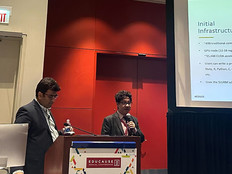Franklin University Manages Their Growth in the Cloud
Cloud computing fuels Franklin University's growth with powerful virtualization hardware and software.
When Franklin University needed an updated IT infrastructure to manage its growth, the college turned to the cloud. The IT team was certain that the fluid environment of a cloud, with shared servers delivering apps and data, often from disparate locations, was the right fit.
But instead of tapping into the commercial cloud of services available over the Internet, Franklin built its own, using VMware virtualization software and high-performance HP servers to create two redundant data centers that deliver pooled services.
"From an IT perspective, we've become an online service provider as we've grown," says John Miller, Franklin's director of technology infrastructure and network services. "What led us to the internal cloud was the need for flexibility and high availability. We're not comfortable, at least not yet, with using services from a generic public cloud, so we've created many of the same benefits inside our organization."
Managing Growth
More than two-thirds of the university's courses are presented entirely online, and 100 percent of them have online content, according to CIO Jeffrey Brotherton.
Franklin maintains a main brick-and-mortar campus in Columbus, Ohio, with several satellite physical facilities in Ohio and Indianapolis. But the 11,000 students enrolled are geographically scattered among all 50 states and at least 50 foreign countries.
"For us, the internal cloud comes out of strategic growth requirements and the realization that our services can't be unavailable to students for any length of time," Brotherton says.
Virtualization was central to the new model. Franklin began a VMware pilot in 2007. At the time, the university's IT infrastructure was running on approximately 150 physical servers, with the learning management system alone requiring about 60 servers to handle operations, development and testing.
The school has grown substantially in the intervening years, and the IT department now maintains 260 servers, but just 54 of them are physical machines. About 80 percent of Franklin's servers are virtualized now, and that figure will grow to 90 percent in the future, says Miller.
The percentage of organizations surveyed that are considering deploying private clouds
SOURCE: IDC, based on responses from 255 U.S. IT decision-makers
But a burgeoning virtual environment does not necessarily make for an internal cloud, says Virtualization Architect Richard Caldwell.
"The internal cloud was the eventual outgrowth of that process of virtualization and development," Caldwell says. "You've created a cloud when you've reached a point where you focus on delivering services, rather than on servers and applications and where they're located."
Franklin's private cloud really took shape in 2010, when the university built a second remote data center with redundant Internet connections to the primary data center. Applications are distributed, shared and moved between the two facilities in a fluid computing environment that spreads the processing load and provides maximum flexibility and availability.
Stored data is continuously replicated between the facilities, enabling rapid failover and disaster recovery.
"If we had a catastrophic disaster in one data center, we could failover to the other data center in a few hours," says Miller.
Virtual Necessities
Some groundwork was necessary before the university could create its cloud, says Miller. Franklin upgraded its virtualization technology and now runs VMware vSphere 4.0, which permits the dynamic utilization of computing capacity by automating resource, capacity and performance management.
The vSphere platform streamlines setup and provisioning of servers, says Miller. A new VM can be up and running 30 minutes after its request is approved, compared with 20 hours for a physical server. Franklin began replacing its old server hardware with HP ProLiant DL380 G6 physical servers, which pack enough punch to support as many as 30 VMs.
"When you virtualize your environment, you're definitely placing a lot of reliance on each of your physical servers," Caldwell says. "If we have 30 virtual servers running on a single piece of hardware, we have to be sure that hardware has sufficient capacity and management features to do the job."
Franklin also had to ramp up its NetApp storage infrastructure to support the virtual ecosystem and handle replication between the two data centers. "The storage that you base the environment on has to be well configured and very robust," says Caldwell. "It's the ability to replicate storage between the two data center locations that gives us higher availability and immediate disaster recovery capability."
Replication between the data centers is one of many reasons that network architecture and design can't be overlooked as factors in making the cloud model work, says Miller. Franklin relies on Cisco switching and has recently adopted Cisco's Nexus converged storage and networking architecture.
"You can create redundant services using VMware, but if you don't have the network set up to properly failover, it doesn't do you any good," he notes.
Enduring ROI
For the IT team at Franklin, the move to virtualization and then to an internal cloud was almost inevitable to keep up with the university's growth. But Brotherton still had the not-so-easy task of securing funding for the project, which has so far required about $2 million in investments, he adds.
"I had to sell up to the administration and sell down to some of my own IT people who were skeptical of the changes we wanted to make," he says.
Because hardware in the university's main data center was reaching end of life and licensing contracts were running out, Franklin was able to build its cloud with the second data center at just 15 percent above the cost of refurbishing the original center, Brotherton says.
The virtualized infrastructure saves the university a half-million dollars annually in hardware lifecycle replacement costs alone, says Brotherton. An internal study has also shown that the cost of maintaining a virtual server over five years is about $5,000, one-sixth of the cost of maintaining a physical server over the same period.
Brotherton, however, sees the savings as even more substantial. "In addition to the physical server, you need network-attached storage, and most of our systems were running on clustered servers for high availability," Brotherton says.
"So to put up a single application in the past, we ended up with two servers and the storage, and would be looking at $40,000 or $50,000. We can do the same thing with a single virtual server and the savings ratio is more like 10-to-1."
For the near future, says Miller, cloud computing at Franklin will have two main focuses: building a robust disaster recovery and continuity of operations plan and deploying virtualized desktops to students.
Desktop virtualization is already being piloted with one class, and its use will spread through all the university's courses, says Miller. The long-term vision is that all Franklin students will work on virtual desktops from which they can access curriculum and the learning management system from any computer at any location.
Although virtual desktops will offer significant advantages in delivery and management of services, the greatest benefits may be those that accrue to online students, says Brotherton. In the past, some classes at the university were only offered face-to-face because they involved expensive software support.
"That meant the 67 percent of our students who study exclusively online couldn't take the class," he says. "If we offered them online, each student had to buy the software. The virtual desktops bring a Franklin education back within reach to someone who's not in central Ohio, or who flat out can't afford a $600 software package."
For now, Franklin will continue to expand and refine its internal cloud, but Brotherton does not dismiss the possibility that the school will eventually use more services from the public cloud – it already uses a hosted payroll and customer relationship management applications.
"Higher education is cautious about releasing information. We want it to be secure and in our control," he says. "We also want to be able to bring any information back if we end a relationship with a vendor. We've decided that right now we and the vendors aren't ready, but that may change in a year or two. As we grow, we may move our overseas operations to the public cloud."
Counting on the Cloud
Cloud computing provides a host of benefits, including:
• Flexibility: Computing resources are directed where they are required at any given time.
• Redundancy: Shared processing and automatic failover maintain performance and tame the threat of disasters or network interruptions.
• Reduced hardware and software costs: Both public and private cloud implementations require less hardware, fewer software purchases and lower maintenance costs.
• Cost control and visibility: Users pay only for the computing services they use, and have insight into levels and patterns of usage.
• Reduced energy costs for private clouds: There is less hardware, and it is used more efficiently, saving on overall energy consumption even if the servers in the cloud are more powerful.
• Reduced virtual server sprawl in private clouds: Self-service provisioning requires approvals, policies and, often, mandated expiration dates for virtual machines.







